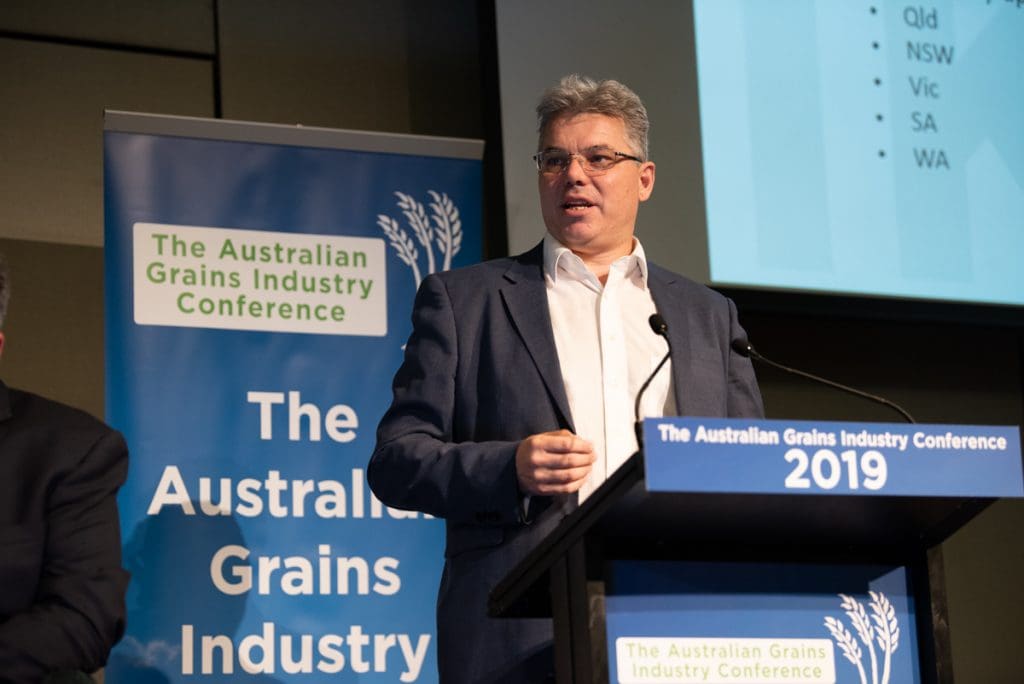DROUGHT in eastern Australia has coincided with a remarkable period of change and investment in the domestic supply chain which, in the absence of buoyancy in grain export markets, was a focus for discussion at the 2019 Australian Grains Industry Conference (AGIC).
Held in Melbourne last Wednesday and Thursday under the title of Navigating the future: A roadmap to 2025, AGIC 2019 brought together many high-level participants in the domestic grains industry, including IKON Commodities director of advisory and projects Ole Houe.
Mr Houe gave an overview to kick off AGIC’s Close to home: Domestic supply-chain opportunities session, which highlighted the enormity of the task at hand.
Doubled feed demand
He compared the growth in grain production over the past 30 years from 20-25 million tonnes to 30-35Mt with a doubling of domestic grain consumption, with 75pc of demand now in the stockfeed sector, and 1.2M head of cattle on feed as one of its key drivers.
“Wheat, barley and sorghum use has gone from over 6Mt to over 13Mt, and more in the dry years.
“We’ve seen the demand more than double over three decades.”
While Australia’s grain supply chain has traditionally fed grain from up-country sites to export terminals, most of them owned by Australia’s major bulk-handling companies (BHCs), Mr Houe said significant structural changes were occurring.
On the port front, he said that included port capacity nationally having increased 20pc in the past decade, and by 50pc in NSW alone.
It has done little to help GrainCorp, which last Friday issued an earnings guidance (see below) to revise up its forecast loss in the current financial year.
This is despite it handling 2.3Mt of an industry-estimated 3.5Mt of South and Western Australian grain arriving by ship to help fill the eastern states’ drought-driven deficit.
“The BHCs’ market share has gone from two-thirds to three-quarters to being 40-45pc, or even one-third in a small year,” Mr Houe said.
“A system that’s built to take grain to export might not be as efficient as one to take grain to end users.
“The first boat was 15-20pc dearer than the last boat; it’s a normalised supply chain now.”
Aside from transhipped grain, Mr Houe said there had been “significant rail movements” of SA grain into central and northern NSW.
“A lot of the learnings from the drought year will continue into the normal year.
Mr Houe said growth in on-farm storage was likely to continue, as was the grain industry’s desire to be able to quantify the amount of grain stored within the supply chain.”
Canadian wheat for use at Manildra’s Bomaderry plant and protein meals to supplement cattle diets are already being imported to help fill the eastern-Australian deficit, and Mr Houe said such shipments may become the new normal.
“I think we’ll see more imports on a more regular basis.”
Portside changes
Port of Melbourne executive general manager commercial Jim Cooper said drought had not stopped the facility from seeing an increase over last year in commodity and container throughput of 8.5pc, but drought had impacted container exports.
“In container trade, exports have reduced by 6pc, and we’ve had a modest increase in imports.”
Mr Cooper said trade was growing in the long term, and the recent arrival of the first of the larger vessels carrying up to 9500 20-foot equivalent units (TEUs).
“That’s a significant increase from the 5000-6000 TEU ships.
“The future and change is coming a lot faster than we’ve anticipated.
“Our role is really around enabling the trade to come when it needs to come, and doing it at the lowest cost.”
Mr Cooper said on-dock rail in Melbourne was in line for significant investment, but infrastructure such as shuttle trains and inter-modal hubs needed to interface with what was happening at the port to maximise efficiencies.
“If you can get double-stack containers, that will improve efficiency.
“With all of that comes reliability, and you will get a modal shift from road to rail.”
Mr Cooper said approval for in-port developments was close, and investment in warehouses, stores and rail spurs linked to the port had started to occur.
“We’re starting to get green shoots.
“I can feel that business energy building among our customers in the past four months.”
Inland Rail opportunities
ARTC manager business development and property Michael Clancy outlined development in the Inland Rail project which will link Brisbane and Melbourne in less than 24 hours, and “fill the jigsaw” in the domestic supply chain when it opens in 2025.
He said the market would decide where inter-modal terminals servicing Inland Rail would be built, and Parkes in central NSW appeared to be a front-runner.
“There is significant work being down with local councils in leveraging off Inland Rail.”
Mr Clancy said train lengths were already increasing from around 650 metres to 1000m on parts of the alignment, and minimum lengths of 1350m and payloads of 5500-6000t could be expected on the completed track.
“That’s the dynamic that will start to drive significant change.”
Riordan Grain Services manager grain services Michelle Kerr said Inland Rail would open up the supply chain to the north of Melbourne.
“We can get better access to customers in the timeframe of 24 hours.
“On the flipside is grain produced out of the north.
“When it does come back on line, it can work into the south.”

The supply-chain panel at AGIC 2019: Ridley general manager merchandising Michael Reeves, Port of Melbourne’s Jim Cooper, ARTC’s Michael Clancy, Riordans’ Michelle Kerr, IKON Commodities director Ole Houe and chair and Wagner Corporation’s business development manager Inland Rail, Peter Wilson. Photo: AGIC
GrainCorp anticipates bigger loss
In an announcement on Friday, major eastern-states bulk-handler GrainCorp Limited said it expected to report underlying earnings before interest, tax, depreciation and amortisation (EBITDA) for the year ended 30 September at $65-85 million, and an underlying net loss after tax of $70-90 million.
GrainCorp expects the full-year negative EBITDA impact arising from the ongoing disruption of international grain trade flows and Australian wheat markets to increase to $60-70M, up from $40M as reported on 18 April.
While it has substantially executed its old-crop position, GrainCorp said new-crop trading opportunities in the final FY19 quarter were no longer expected to materialise due to reluctance from international market participants to consider new-season contracts.
“This is an extremely difficult year for GrainCorp due to the significant disruptions we’ve seen in global grain markets, compounded by the drought in eastern Australia,” GrainCorp chief executive officer Mark Palmquist said.
“The extraordinary circumstances in eastern Australia are highlighted by the fact we expect to ship 2.3Mt of grain from South and Western Australia to meet east-coast domestic demand.”
Grain Central: Get our free cropping news straight to your inbox. Simply fill in and submit the ‘sign up’ box at the bottom right-hand corner of this page.


HAVE YOUR SAY